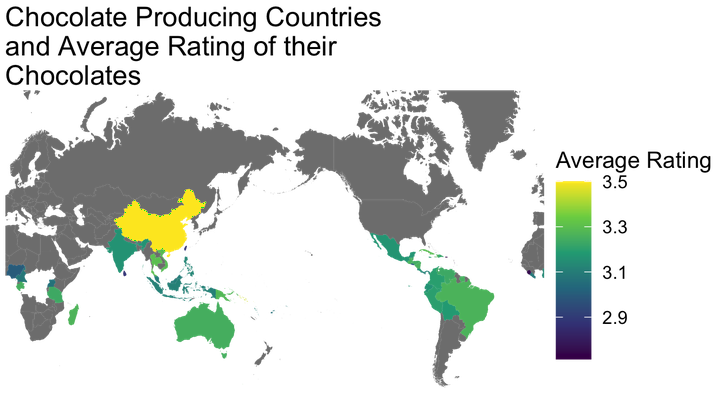This week for #TidyTuesday the dataset comes from Flavors of Cacao. Interesting set of information on chocolate ratings from across the world. Code below the figures.
I first wanted to look at the data statistically. I was curious if percent of cocoa in the chocolate was related to the rating. Looks like there is a significant relationship.

I then took a what other factors are possibly influencing the rating, including cocoa percent and different ingredients in the chocolate. Containing vanilla and cocoa butter are possibly influencing the chocolate ratings.

To look at the data differently, I plotted the average rating of the chocolate based on it’s origins. There were multiple chocolates that were blends from different countries, which do not factor into this. There is also an error in the mapping which left some countries out.

library(tidytuesdayR)
library(tidyverse)
library(ggplot2)
library(sjPlot)
library(RColorBrewer)
library(maps)
tuesdata <- tidytuesdayR::tt_load('2022-01-18')
chocolate <- tuesdata$chocolate
chocolate <- chocolate %>%
mutate(
cocoa_percent = str_extract(cocoa_percent, "\\d+") %>%
as.numeric()
)%>%
mutate(country_of_bean_origin=
recode(country_of_bean_origin,
"Congo"= "Republic of Congo",
"DR Congo"= "Democratic Republic of the Congo")
)
chocolate_df<- chocolate %>%
mutate(
n_ingredients = str_extract(ingredients, "\\d") %>% as.numeric(),
ingredients_list = str_extract(ingredients, "[A-Za-z,*]+")
) %>%
separate_rows(
ingredients_list,
sep = ","
) %>%
mutate(
ingredients_list = str_replace_all(
ingredients_list,
c(
"^S\\*$" = "sweetener",
"^S$" = "sugar",
"C" = "cocoa_butter",
"V" = "vanilla",
"B" = "beans",
"L" = "lecithin",
"^Sa$" = "salt"
)
),
ingredients_list = replace_na(ingredients_list, "unknown"),
flag = 1
) %>%
pivot_wider(
names_from = ingredients_list,
values_from = flag,
values_fill = 0
)
graph <- ggplot(chocolate_df, aes(x = cocoa_percent, y = rating)) +
geom_point() +
stat_smooth(method = "lm", col = "red")+
labs(x='Cocoa Percent', y='Rating', title='Linear Regression Plot') +
theme(plot.title = element_text(hjust=0.5, size=20, face='bold'))+
theme_minimal()+
annotate("text", x = 45, y = 1.1, label = "italic(R) ^ 2 == 0.021", parse= TRUE)
graph
model1 <- lm(rating ~
cocoa_percent,
data= chocolate_df
)
summary(rating)
model2 <- lm(rating ~
cocoa_percent+
sweetener+
sugar+
cocoa_butter+
vanilla+
beans+
lecithin+
salt,
data=chocolate_df)
model3 <- lm(rating ~
sweetener+
sugar+
cocoa_butter+
vanilla+
beans+
lecithin+
salt,
data=chocolate_df)
tab_model(model1, model2, model3,
dv.labels = c("Model 1", "Model 2", "Model 3"),
show.ci= FALSE,show.est=F,
show.std=T, show.stat=T, show.p= TRUE, p.style = "stars",
string.pred = "Rating",
string.std="B", string.stat="p")
chocolate_df2 <- chocolate_df %>%
group_by(country = country_of_bean_origin)%>%
summarise(avg_rating=mean(na.omit(rating)),
avg_cocoa=mean(na.omit(cocoa_percent)))
countries <- read_csv("2022-01-18/countries.csv")
chocolate_df2 <- right_join(chocolate_df2, countries, by="country")
world <- map_data("world2")%>%
filter(region != "Antarctica")
worldmap <- chocolate_df2 %>%
ggplot(aes(map_id=country))+
geom_map(aes(fill=avg_rating), map=world)+
expand_limits(x= world$long, y=world$lat)+
scale_fill_continuous(type = "viridis")+
coord_map("mercator")+
labs(fill = "Average Rating", title= str_wrap("Chocolate Producing Countries and Average Rating of their Chocolates", 30))+
theme(legend.position="bottom", plot.title = element_text(hjust =0.5))+
theme_void()
ggsave("featured.png")



